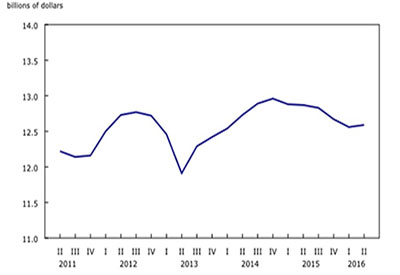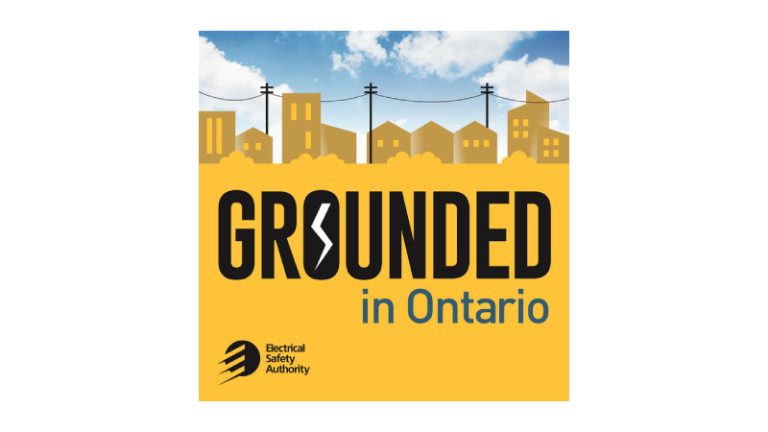Q2 2016 Investment in non-residential building construction Rises Slightly

July 21, 2016
Investment in non-residential building construction increased 0.2% to $12.6 billion in the second quarter, following five consecutive quarterly declines. Nationally, the growth was a result of higher spending on the construction of commercial buildings and, to a lesser extent, industrial buildings.
Overall, investment was up in four provinces, with Ontario registering the largest gain, followed by British Columbia and Manitoba.
Chart 1: Investment in non-residential building construction
In Ontario, the advance was largely the result of higher investment in the commercial and industrial components. In British Columbia, increased spending on commercial buildings accounted for the advance, while in Manitoba, commercial and industrial projects were responsible for the gain.
The largest declines occurred in Alberta and Quebec. Investment in Alberta continued its downward trend, with a fifth consecutive quarterly decline, largely the result of lower spending for commercial and industrial buildings. In Quebec, the decrease was attributable to lower institutional investment.
Census metropolitan areas
Non-residential building construction spending was up in 14 of the 34 census metropolitan areas in the second quarter. The largest gains were in Winnipeg and Ottawa.
Following five consecutive quarterly declines, investment advanced in all three components in Winnipeg. The gains were led by higher spending on commercial and industrial buildings. In Ottawa, the increase largely resulted from higher spending on commercial projects.
In contrast, the largest declines occurred in Montreal, distantly followed by Calgary and St. John’s.
In Montreal, investment was down for a fifth consecutive quarter, mainly as a result of lower spending on the construction of institutional buildings.
The decline in Calgary was attributable to commercial and institutional investment, while in St. John’s, spending was down in all three components.
Commercial component
Following five quarterly declines, investment in commercial building construction rose 0.9% to $7.4 billion in the second quarter. The gain was the result of higher investment in the construction of office buildings, retail and wholesale outlets, and recreational centres.
Four provinces posted advances, mainly due to higher spending among several categories within the commercial component.
In Ontario, investment was up 2.7% to $2.8 million, due to higher spending on most types of commercial projects, led by office buildings, retail and wholesale stores, and warehouses.
In British Columbia, spending rose 5.9% to $981 million, a fifth consecutive quarterly increase. In Manitoba, commercial investment was up 8.5% to $227 million. In both provinces, the gains came mainly from higher spending on the construction of office buildings and retail and wholesale outlets.
Alberta recorded the largest decrease, as commercial investment was down 2.5% to $1.7 billion, the fifth consecutive quarterly decline. Lower investment in the construction of warehouses was largely responsible for the drop.
Chart 2: Commercial, institutional and industrial components
Industrial component
Following five quarterly declines, investment in industrial building construction increased 0.9% to $1.8 billion in the second quarter, mainly due to higher spending on primary industry facilities and utilities buildings.
Quebec posted the largest gain, as construction of industrial buildings rose 7.2% to $340 million. The increase was led by higher spending on primary industries facilities, utilities and maintenance-related buildings.
Ontario and Manitoba also recorded notable advances. The gains in Ontario were led by increased spending on maintenance-related and primary industry buildings, while in Manitoba, higher construction spending on utilities buildings and manufacturing plants largely accounted for the advance.
Alberta and Saskatchewan posted the largest declines. Lower spending on manufacturing plants and maintenance-related buildings was responsible for the decline in Alberta, while in Saskatchewan, the decrease was attributable to lower investment in utilities buildings.
Institutional component
Investment in institutional projects fell 1.6% to $3.4 billion in the second quarter, following a decline the previous quarter.
Six provinces posted decreases, led by Quebec, followed distantly by Ontario and British Columbia. Lower spending on medical facilities was the primary reason for the declines.
Saskatchewan and the Northwest Territories each reported higher spending on health care facilities.
Source: Statistics Canada, www.statcan.gc.ca/daily-quotidien/160715/dq160715b-eng.htm.







![Guide to the Canadian Electrical Code, Part 1[i], 25th Edition– A Road Map: Diagrams and Appendices](https://electricalindustry.ca/wp-content/uploads/2022/11/Guide-CE-Code-2-768x432.png)










